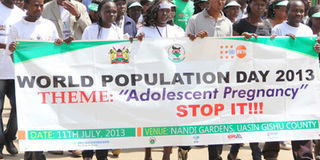Sustain progress in caring for humanity for inclusiveness and equality

Kenyans mark World Population Day on July 11, 2013 in Eldoret Town. This year's theme is “25 Years of the ICPD: Accelerating the Promise”. PHOTO | FILE | NATION MEDIA GROUP
What you need to know:
In developing countries, many women die every day from preventable causes during pregnancy or while giving birth.
Globally, about 39,000 girls are forced into marriages every day while four million are subjected to female genital cutting yearly.
The world must make bold and courageous moves to get to the three zeros:
Zero unmet needs for family planning; zero maternal deaths; and zero violence and harmful practices against women and girls, including child marriage and female genital cutting.
The annual World Population Day, first marked on July 11, 1987, keeps track of progress by United Nations member states on urgent and emerging population issues. Great progress has since been made amid challenges.
REPRODUCTIVE HEALTH
In 1987, the world population was an estimated five billion; today, it is 7.3 billion. That year, Kenya had 21 million people, but it has 52 million today. The figures have doubled over time for reasons such as improved maternal healthcare for women and girls, lower percentage of underage girls being forced into early marriages and more girls in school and in workplaces.
Then, reproductive and sexual health was an adage, the rights of women and girls could not be spoken about loudly in public, family planning services were the preserve of a few urban elites, female genital cutting of women and girls was rampant and education for women in Kenya was picking up slowly.
Today, more women have access to sexual reproductive health services, fewer girls are subjected to child marriage and fewer women die from pregnancy-related complications. The number of maternal deaths each year, for example, decreased by about 40 per cent over the past 25 years and one in five girls is forced into marriage before she turns 18, against one in three in 1994.
Despite the impressive gains, however, additional efforts are needed to reach those who have been left behind. Of much concern is some 214 million women who want to prevent pregnancies but do not use modern methods of contraception.
In developing countries, many women die every day from preventable causes during pregnancy or while giving birth. Globally, about 39,000 girls are forced into marriages every day while four million are subjected to female genital cutting yearly.
Over the years, Kenya has experienced rapid declines in mortality rates, in the 1970s and ’80s, followed by an upsurge in mortality at all ages in the ’90s. However, life expectancy at birth declined from 58 to 54 years for males and 61 to 57 years for females in the past decade. But this has so far increased to 58 years for males and 61 years for females according to the last census.
LIFE EXPECTANCY
The average life expectancy at birth for both sexes was estimated at 62.6 years in 2013, increasing to 63.4 years in 2015. Today, female life expectancy at birth is estimated at 65.8 years and 61.1 years for men.
The estimates suggest that, since 2000, life expectancy has increased at the rate of 0.8 years per year (about 1.3 per cent annual increase). This has been attributed to recent declines in both child and adult mortality.
The world must make bold and courageous moves to get to the three zeros: Zero unmet needs for family planning; zero maternal deaths; and zero violence and harmful practices against women and girls, including child marriage and female genital cutting.
As we rhyme with the theme of this day, “25 Years of the ICPD: Accelerating the Promise”, we envision inclusiveness and equality for all. We must strengthen and empower conversations to accelerating the promise. More importantly, we must renew our focus to leaving no one behind.
Dr Kibaru-Mbae is the director-general, National Council for Population and Development. [email protected] @NCPD_Kenya




